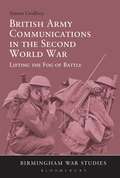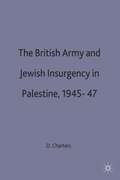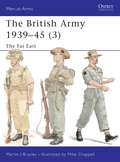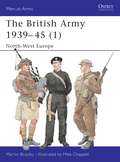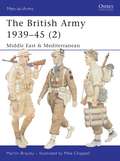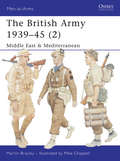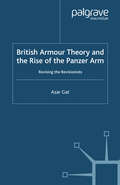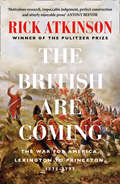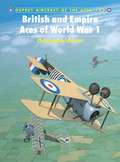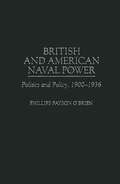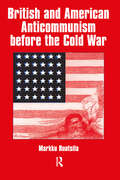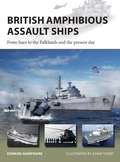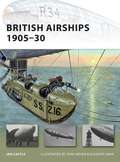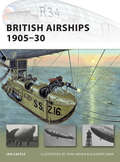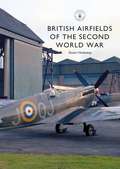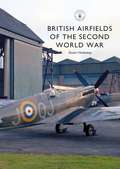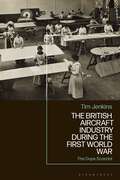- Table View
- List View
British Army Communications in the Second World War: Lifting the Fog of Battle (Birmingham War Studies)
by Simon GodfreyCommand, Control, Communications and Intelligence form the backbone of the Army's operating system. But while much attention has been given in the literature to the other three elements, Communications in the British Army during World War II have been widely ignored. This book rectifies the omission. It shows that failures in front line communications contributed to several of the set backs suffered by the Army but also that ultimate victory was only achieved after a successful communications system was in place. It explains how the outcome of the main campaigns in Europe and North Africa depended on communications, how the system operated and how it evolved from a relatively primitive and inadequately supplied state at Dunkirk to a generally effective system at the time of the Rhine crossings. Problems still occurred however, for example at infantry platoon level and famously with paratrooper communications at Arnhem, often simply due to the shortcomings of existing technology. The book concludes that it is only very recently that advances in technology have allowed those problems to be solved.
British Army Communications in the Second World War: Lifting the Fog of Battle (Birmingham War Studies)
by Simon GodfreyCommand, Control, Communications and Intelligence form the backbone of the Army's operating system. But while much attention has been given in the literature to the other three elements, Communications in the British Army during World War II have been widely ignored. This book rectifies the omission. It shows that failures in front line communications contributed to several of the set backs suffered by the Army but also that ultimate victory was only achieved after a successful communications system was in place. It explains how the outcome of the main campaigns in Europe and North Africa depended on communications, how the system operated and how it evolved from a relatively primitive and inadequately supplied state at Dunkirk to a generally effective system at the time of the Rhine crossings. Problems still occurred however, for example at infantry platoon level and famously with paratrooper communications at Arnhem, often simply due to the shortcomings of existing technology. The book concludes that it is only very recently that advances in technology have allowed those problems to be solved.
British Army and Jewish Insurgency in Palestine, 1945-47: Studies in Military and Strategic History (PDF)
by David A. ChartersThe first comprehensive scholarly study of the British Army's campaign against the Jewish insurgency in postwar Palestine, this book shows how outdated doctrine, traditional resistance to change, and postwar turbulence hampered the army's efforts to modify its counter-insurgency tactics. It also shows why the security forces failed to develop intelligence sufficient to defeat the insurgents.
The British Army 1939–45: The Far East (Men-at-Arms)
by Mike Chappell Martin BrayleyThe lightning Japanese offensives in the Far East in 1941/42 inflicted a series of costly defeats on the ill-prepared and badly supported British Commonwealth forces in Malaya and Burma. The 'forgotten' 14th Army on the India-Burma border slowly built up its strength and its tactical expertise; and Wingate's 'Chindits' proved that units supplied from the air could operate deep behind enemy lines. In 1944 General Slim's troops decisively smashed Japan's last offensive at Imphal and Kohima; and over the next year they drove the enemy relentlessly back through Burma, reducing them to starving fugitives by the final victory in August 1945. This concise summary of Britain's Far East campaigns is illustrated with many rare photographs, and eight detailed colour plates.
The British Army 1939–45: North-West Europe (Men-at-Arms)
by Mike Chappell Martin BrayleyThe Second World War was Britain's last conflict as a world power. For a year it saw Britain standing alone against the fascist dictatorships; winning it demanded the sacrifice of the entire national wealth. This first book of three describes the uniforms developed for European service. It traces the appearance of the 'Tommy' from pre-war mobilization, through the years of defeat and endurance, to D-Day and the long fighting advance to Northern Germany. The book also includes a campaign summary, infantry organization tables, lists of arms and services and basic specifications of a number of heavy weapons.
The British Army 1939–45: Middle East & Mediterranean (Men-at-Arms)
by Mike Chappell Martin BrayleyThe scope of Britain's wartime Middle East Command stretched far beyond the Libyan desert where the 8th Army's most famous battles were fought from Gibraltar and Tunisia in the west, to Iraq and Persia in the east, and from Greece south to the Gulf of Aden. In 1940-43 this was the only arena where the British Army could take the ground war to the German Wehrmacht; it saw a succession of setbacks and triumphs, until spring 1945 found the 8th Army victorious in northern Italy. A summary of these campaigns is illustrated by photographs, and detailed colour plates of the wide range of uniforms worn in the varied conditions of this huge theatre of war.
The British Army 1939–45: North-West Europe (Men-at-Arms)
by Mike Chappell Martin BrayleyThe Second World War was Britain's last conflict as a world power. For a year it saw Britain standing alone against the fascist dictatorships; winning it demanded the sacrifice of the entire national wealth. This first book of three describes the uniforms developed for European service. It traces the appearance of the 'Tommy' from pre-war mobilization, through the years of defeat and endurance, to D-Day and the long fighting advance to Northern Germany. The book also includes a campaign summary, infantry organization tables, lists of arms and services and basic specifications of a number of heavy weapons.
The British Army 1939–45: The Far East (Men-at-Arms #375)
by Mike Chappell Martin BrayleyThe lightning Japanese offensives in the Far East in 1941/42 inflicted a series of costly defeats on the ill-prepared and badly supported British Commonwealth forces in Malaya and Burma. The 'forgotten' 14th Army on the India-Burma border slowly built up its strength and its tactical expertise; and Wingate's 'Chindits' proved that units supplied from the air could operate deep behind enemy lines. In 1944 General Slim's troops decisively smashed Japan's last offensive at Imphal and Kohima; and over the next year they drove the enemy relentlessly back through Burma, reducing them to starving fugitives by the final victory in August 1945. This concise summary of Britain's Far East campaigns is illustrated with many rare photographs, and eight detailed colour plates.
The British Army 1939–45: Middle East & Mediterranean (Men-at-Arms #368)
by Mike Chappell Martin BrayleyThe scope of Britain's wartime Middle East Command stretched far beyond the Libyan desert where the 8th Army's most famous battles were fought from Gibraltar and Tunisia in the west, to Iraq and Persia in the east, and from Greece south to the Gulf of Aden. In 1940-43 this was the only arena where the British Army could take the ground war to the German Wehrmacht; it saw a succession of setbacks and triumphs, until spring 1945 found the 8th Army victorious in northern Italy. A summary of these campaigns is illustrated by photographs, and detailed colour plates of the wide range of uniforms worn in the varied conditions of this huge theatre of war.
British Armour Theory and the Rise of the Panzer Arm: Revising the Revisionists (St Antony's Series)
by A. GatUtilizing hitherto untapped archival sources, Azar Gat overturns recent historiographical trends in the study of British and German armour developments between the two World Wars. He reinstates British pioneering theory and practice as the inspiration for the creators of the Panzer arm that made possible Germany's 'Blitzkrieg' victories in the opening stage of World War II.
The British Are Coming: The War For America, Lexington To Princeton, 1775-1777 (The\revolution Trilogy Ser. #1)
by Rick Atkinson‘To say that Atkinson can tell a story is like saying Sinatra can sing … A powerful new voice has been added to the dialogue about [America’s] origins as a people and a nation. It is difficult to imagine any reader putting this beguiling book down without a smile and a tear.’ New York Times
British and Empire Aces of World War 1 (Aircraft of the Aces)
by Christopher Shores Mark RolfeAt the outset of World War I the British had some 110 assorted aircraft, used mostly for the visual reconnaissance role. With the advent of faster and more agile single-seaters, the Allies and their adversaries raced to outdo each other in the creation of genuinely effective fighters with fixed forward-firing machine gun armament. It was not until 1917 that the British developed a truly effective interrupter gear, which paved the way for excellent single seaters such as the Sopwith Triplane Camel and the RAF S.E.5., later joined by the Bristol F.2B the war's best two-seat fighter. This volume traces the rapid development of the fighter in World War I and the amazing exploits of the British and Empire aces who flew them.
British and Empire Aces of World War 1 (Aircraft of the Aces #45)
by Christopher Shores Mark RolfeAt the outset of World War I the British had some 110 assorted aircraft, used mostly for the visual reconnaissance role. With the advent of faster and more agile single-seaters, the Allies and their adversaries raced to outdo each other in the creation of genuinely effective fighters with fixed forward-firing machine gun armament. It was not until 1917 that the British developed a truly effective interrupter gear, which paved the way for excellent single seaters such as the Sopwith Triplane Camel and the RAF S.E.5., later joined by the Bristol F.2B the war's best two-seat fighter. This volume traces the rapid development of the fighter in World War I and the amazing exploits of the British and Empire aces who flew them.
British and American Naval Power: Politics and Policy, 1900-1936 (Praeger Studies in Diplomacy and Strategic Thought)
by Phillips O'BrienU.S. and British naval power developed in quite different ways in the early 20th century before the Second World War. This study compares, contrasts, and evaluates both British and American naval power as well as the politics that led to the development of each. Naval power was the single greatest manifestation of national power for both countries. Their armies were small and their air forces only existed for part of the period covered. For Great Britain, naval power was vital to her very existence, and for the U.S., naval power was far and away the most effective tool the country could use to exercise armed influence around the world. Therefore, the decisions made about the relative strengths of the two navies were in many ways the most important strategic choices the British and American governments ever made. An important book for military historians and those interested in the exercise and the extension of power.
British and American Anti-communism Before the Cold War
by Markku RuotsilaThis work examines in a comparative historical way the socialist, liberal and conservative strands of Anglo-American anticommunist thought before the Cold War. In so doing, this book provides us with an intellectual pre-history of Cold War attitudes and policy positions.
British and American Anti-communism Before the Cold War
by Markku RuotsilaThis work examines in a comparative historical way the socialist, liberal and conservative strands of Anglo-American anticommunist thought before the Cold War. In so doing, this book provides us with an intellectual pre-history of Cold War attitudes and policy positions.
British Amphibious Assault Ships: From Suez to the Falklands and the present day (New Vanguard)
by Edward HampshireAmphibious assault ships have been at the centre of nearly all of Britain's expeditionary campaigns since World War II, from the Suez crisis of 1956 to operations as far afield as Borneo (1963–66), the Falklands (1982), Sierra Leone (2000) and Iraq (2003). In major operations such as Suez and the Falklands, the use of amphibious assault ships was essential to the military success of the campaigns. The Suez Crisis saw two of the Royal Navy's former light fleet carriers converted into 'commando carriers' to specialise in amphibious warfare. In the 1960s these were followed by the famous Fearless class ships – the first purpose-built amphibious assault ships in the Royal Navy. With an internal dock, headquarters capability, and multiple landing craft, these 'Landing Platform Docks' were built to project power around the world. When the Falklands were invaded, HMS Fearless was the key to the successful landing in San Carlos. In the 1990s, a new generation was ordered: the helicopter carrier HMS Ocean and the Albion class LPDs. In recent years Ocean, Albion and Bulwark have been the largest fighting ships of the Royal Navy and have acted as the navy's flagships, as well as being perhaps the most versatile ships in the navy. This title is an essential guide to British Amphibious Assault Ships across the decades, from the mighty Fearless to the modern Albion. Packed with full-colour illustrations, contemporary photography, and detailed analysis, this definitive work explores the history, development, and deployment of the Royal Navy's front line.
British Amphibious Assault Ships: From Suez to the Falklands and the present day (New Vanguard #277)
by Edward HampshireAmphibious assault ships have been at the centre of nearly all of Britain's expeditionary campaigns since World War II, from the Suez crisis of 1956 to operations as far afield as Borneo (1963–66), the Falklands (1982), Sierra Leone (2000) and Iraq (2003). In major operations such as Suez and the Falklands, the use of amphibious assault ships was essential to the military success of the campaigns. The Suez Crisis saw two of the Royal Navy's former light fleet carriers converted into 'commando carriers' to specialise in amphibious warfare. In the 1960s these were followed by the famous Fearless class ships – the first purpose-built amphibious assault ships in the Royal Navy. With an internal dock, headquarters capability, and multiple landing craft, these 'Landing Platform Docks' were built to project power around the world. When the Falklands were invaded, HMS Fearless was the key to the successful landing in San Carlos. In the 1990s, a new generation was ordered: the helicopter carrier HMS Ocean and the Albion class LPDs. In recent years Ocean, Albion and Bulwark have been the largest fighting ships of the Royal Navy and have acted as the navy's flagships, as well as being perhaps the most versatile ships in the navy. This title is an essential guide to British Amphibious Assault Ships across the decades, from the mighty Fearless to the modern Albion. Packed with full-colour illustrations, contemporary photography, and detailed analysis, this definitive work explores the history, development, and deployment of the Royal Navy's front line.
British Airships 1905–30 (New Vanguard)
by Tony Bryan Ian CastleThis book reveals the fascinating story of the cat and mouse duel between the airship and another pioneering form of technology – the submarine during World War 1. Detailed cut-away drawings reveal the design and development of the airship, during and after the war, whilst full-colour illustrations depict the airship in dramatic action shots. A tragic accident in 1930 brought the airship's military service to an end, resulting in a tiny window in which they were used and little acknowledgement over the years. Ian Castle gives deserved attention to an aeronautical wonder that for a short amount of time played a crucial service to the defence of Britain.
British Airships 1905–30 (New Vanguard)
by Tony Bryan Ian CastleThis book reveals the fascinating story of the cat and mouse duel between the airship and another pioneering form of technology – the submarine during World War 1. Detailed cut-away drawings reveal the design and development of the airship, during and after the war, whilst full-colour illustrations depict the airship in dramatic action shots. A tragic accident in 1930 brought the airship's military service to an end, resulting in a tiny window in which they were used and little acknowledgement over the years. Ian Castle gives deserved attention to an aeronautical wonder that for a short amount of time played a crucial service to the defence of Britain.
British Airfields of the Second World War (Shire Library)
by Stuart HadawayThe Second World War airfields peppered around Britain are among the most visible and widespread reminders of this devastating conflict. Some are now almost forgotten or built over; others have become museums, industrial estates or parkland; and some have been adapted and remain in operation today. In this beautifully illustrated history, aviation historian Stuart Hadaway explains the crucial part airfields played between 1939 and 1945, detailing their construction and expansion; their facilities and equipment; the many functions they housed from command and control to maintenance and bomb-loading; how the airfields were used both for defence and offence; and how they changed during the war. He also explores what life was like on the airfields, as well as listing some of the remaining sites and what can be seen today.
British Airfields of the Second World War (Shire Library)
by Stuart HadawayThe Second World War airfields peppered around Britain are among the most visible and widespread reminders of this devastating conflict. Some are now almost forgotten or built over; others have become museums, industrial estates or parkland; and some have been adapted and remain in operation today. In this beautifully illustrated history, aviation historian Stuart Hadaway explains the crucial part airfields played between 1939 and 1945, detailing their construction and expansion; their facilities and equipment; the many functions they housed from command and control to maintenance and bomb-loading; how the airfields were used both for defence and offence; and how they changed during the war. He also explores what life was like on the airfields, as well as listing some of the remaining sites and what can be seen today.
The British Aircraft Industry during the First World War: The Dope Scandal
by Dr Tim JenkinsIn this book, Tim Jenkins examines the factory worker poisonings and suspect government procurement procedures that resulted in Allied success in the air during First World War.The early development of aircraft during World War I was an important yet dangerous part of the war effort seen in the First World War and although many descriptions of daring aerial combat have been written, the risk to those involved in the manufacture of such machines remains less well known. Tetrachlorethane, a poisonous solvent contained in aircraft dope, was responsible for a number of civilian deaths in aircraft factories and although the British knew the substance to be lethal, they were much slower than their American and German counterparts in sourcing alternatives. In this groundbreaking book, Tim Jenkins explores the use of Tetrachlorethan and brings to light the concerns and warnings voiced by the international medical profession. His examination considers the government's reasons for its use of the poisonous solvent to create a compelling yet scholarly account which takes in corruption, negligence and wartime manufacture. This book will be vital to scholars studying military production during the First World War.
The British Aircraft Industry during the First World War: The Dope Scandal
by Dr Tim JenkinsIn this book, Tim Jenkins examines the factory worker poisonings and suspect government procurement procedures that resulted in Allied success in the air during First World War.The early development of aircraft during World War I was an important yet dangerous part of the war effort seen in the First World War and although many descriptions of daring aerial combat have been written, the risk to those involved in the manufacture of such machines remains less well known. Tetrachlorethane, a poisonous solvent contained in aircraft dope, was responsible for a number of civilian deaths in aircraft factories and although the British knew the substance to be lethal, they were much slower than their American and German counterparts in sourcing alternatives. In this groundbreaking book, Tim Jenkins explores the use of Tetrachlorethan and brings to light the concerns and warnings voiced by the international medical profession. His examination considers the government's reasons for its use of the poisonous solvent to create a compelling yet scholarly account which takes in corruption, negligence and wartime manufacture. This book will be vital to scholars studying military production during the First World War.
